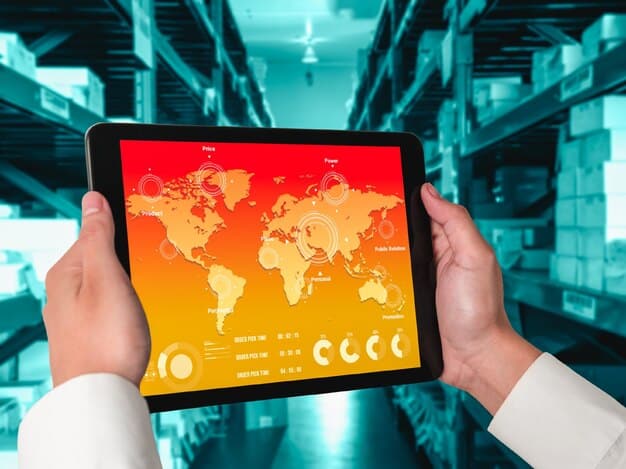US Foreign Policy’s 2025 Impact on International Trade Agreements

The evolving landscape of US foreign policy in 2025 is poised to significantly reshape international trade agreements, influencing global economic stability, supply chain resilience, and the future of multilateral partnerships as nations adapt to new geopolitical realities.
As we look towards the horizon of 2025, a critical question emerges for businesses, policymakers, and citizens alike: How Will the New US Foreign Policy Affect International Trade Agreements in 2025? This inquiry is not merely academic; it delves into the very fabric of global commerce, supply chains, and international relations. The intricate dance between diplomatic strategies and economic policies is set to redefine the terms of engagement on the international stage, demanding a nuanced understanding of potential shifts and their far-reaching implications.
Understanding the Shifting Sands of US Foreign Policy
The trajectory of US foreign policy has always been a bellwether for global stability, particularly concerning international trade. In 2025, we anticipate a landscape shaped by evolving geopolitical competition, technological advancements, and domestic priorities that collectively influence Washington’s approach to global commerce. Understanding these foundational shifts is crucial for deciphering their potential impact on existing and future trade agreements.
A key element to consider is the continued emphasis on “America First” principles, even if articulated differently across administrations. This often translates into policies prioritizing domestic industries, national security interests, and the renegotiation of trade deals perceived as disadvantageous. Such an inward-looking stance can lead to a more protectionist trade environment, characterized by tariffs, quotas, and non-tariff barriers designed to safeguard American jobs and manufacturing capabilities. The ripple effects of such policies often extend globally, prompting other nations to reassess their own trade relationships and strategies.
The Geopolitical Imperative and Economic Statecraft
Foreign policy is rarely formulated in a vacuum; it is deeply intertwined with geopolitical realities. In 2025, heightened tensions with strategic rivals, competition for critical resources, and the imperative to secure supply chains are likely to drive US foreign policy decisions, subsequently impacting trade agreements. Economic statecraft, the use of economic tools to achieve foreign policy objectives, is expected to become an even more prominent feature.
- Sanctions and Export Controls: The strategic deployment of sanctions against specific entities or nations, and the tightening of export controls on dual-use technologies, can disrupt established trade flows and force companies to re-evaluate their global operations.
- Friend-Shoring and Ally-Shoring: There’s a growing emphasis on rerouting supply chains to “friend-shore” or “ally-shore” production, moving away from adversaries to bolster economic security and reduce dependencies on potentially unstable regions.
- Critical Minerals and Technology Dominance: Policies will likely prioritize securing access to critical minerals and maintaining technological leadership, influencing trade agreements related to sectors like semiconductors, renewable energy, and artificial intelligence.
These geopolitical considerations can lead to a fragmentation of global trade, where economic blocs form around geopolitical alliances rather than purely economic efficiencies. Businesses operating internationally will need to navigate this increasingly complex and politicized trade environment. The convergence of national security and economic policy means that every trade agreement, whether bilateral or multilateral, will be scrutinized through a geopolitical lens, aiming to enhance national resilience and strategic advantage. The nuances of these relationships will dictate the next wave of trade negotiations, moving beyond simple tariff reductions to broader concepts of economic security.
Domestic Pressures and Economic Realignments
Domestic economic conditions and political dynamics within the US also exert considerable influence on foreign policy, and by extension, trade agreements. Public opinion regarding globalization, the impact of automation on employment, and the desire for equitable growth can shape the administration’s trade agenda.
The push for reinvestment in domestic infrastructure, clean energy, and advanced manufacturing might prompt policies that favor local production over cheaper imports. This could involve direct subsidies, tax incentives, or “Buy American” provisions in government procurement, all of which indirectly affect international trade flows. Furthermore, labor rights and environmental standards are increasingly becoming integral components of trade negotiations, reflecting domestic values and consumer demands. Any new trade agreement is likely to face intense scrutiny from various domestic stakeholders, ensuring that it aligns with broader societal and economic goals.
Ultimately, the shifting sands of US foreign policy in 2025 will necessitate adaptability from international businesses and governments. The complex interplay of geopolitical strategy, technological competition, and domestic priorities will dictate the terms of trade, creating both challenges and opportunities for those prepared to navigate this evolving landscape. A proactive approach to understanding these underlying drivers will be essential for success in the dynamic global trade environment of 2025 and beyond.
Renegotiation and Reimagining of Existing Agreements
As the geopolitical chessboard shifts, the US foreign policy stance in 2025 is poised to initiate a significant period of renegotiation and reimagining for existing international trade agreements. This isn’t merely about tweaking clauses; it’s about a fundamental re-evaluation of how these pacts serve US economic and strategic interests in a rapidly changing world. The focus is likely to be on agreements perceived as outdated or no longer aligned with contemporary challenges like supply chain resilience, national security, and technological competition.
The renegotiation process will likely target specific aspects of existing agreements that are deemed either unfair to American workers and businesses or strategically disadvantageous. This can involve revisiting tariff schedules, intellectual property protections, labor and environmental standards, and dispute resolution mechanisms. The intent is often to achieve greater reciprocity and to ensure that trade benefits are more equitably distributed, from the US perspective. Such an approach can create uncertainty for businesses that have built their operations around current trade rules, necessitating careful contingency planning.
Targeted Revisions: From NAFTA to Bilateral Deals
The precedent set by the renegotiation of NAFTA into the USMCA demonstrated a clear willingness by the US to overhaul foundational trade pacts. In 2025, similar targeted revisions could be on the agenda, affecting a broader range of agreements.
- USMCA Review: While relatively new, the USMCA (United States-Mexico-Canada Agreement) includes a regular review mechanism, which could be activated to address new concerns related to labor, automotive rules of origin, or digital trade.
- Long-Standing Bilateral Agreements: Older bilateral trade agreements, particularly those with countries that have developed significantly since their inception, may come under scrutiny for imbalance or lack of contemporary relevance.
- WTO Commitments: Though not a direct renegotiation, the US may continue to challenge specific World Trade Organization (WTO) rulings or push for reforms within the organization, indirectly influencing the operational framework of multilateral trade.
These revisions are not just about economic terms; they often carry significant geopolitical weight. They can be used as leverage to encourage behavioral changes in partner nations, align strategic interests, or address concerns about human rights and governance. The complexity lies in balancing the desire for stronger domestic protections with the need to maintain crucial international alliances and avoid an overly protectionist stance that could trigger retaliatory measures. The outcomes of these negotiations will set new precedents for how the US engages with global trade partners, fostering a more dynamic and potentially less predictable environment.
Digital Trade and Emerging Technologies
A significant focus of the reimagining effort will be on how existing agreements address digital trade and emerging technologies. Many current pacts were drafted before the exponential growth of the digital economy, leaving gaps in regulations for data flows, digital services, and the use of artificial intelligence.

The US is likely to push for new provisions that ensure free data flows across borders, prohibit data localization requirements, and establish clear rules for cross-border digital services. This is driven by the understanding that the future of global trade will be increasingly digital and that a robust framework is essential for American tech companies to compete globally. Furthermore, the inclusion of clauses related to emerging technologies, such as cybersecurity standards, intellectual property for AI, and ethical guidelines for technology deployment, will become increasingly common.
Such efforts aim to future-proof trade agreements, making them relevant for the next generation of commerce. However, differing national approaches to data privacy, digital taxation, and technological regulation could pose challenges to achieving consensus. The balance between fostering innovation and ensuring national security in the digital realm will be a delicate tightrope walk in these negotiations. The emphasis will be on creating frameworks that support open digital economies while safeguarding critical national interests and ensuring fair competition among digital service providers.
In essence, 2025 will be a period where the US seeks to recalibrate its trade relationships, not just economically but strategically. The renegotiation and reimagining of existing agreements will be a central pillar of this recalibration, requiring partners to adapt to new expectations and pushing the global trading system towards a more fragmented, yet potentially more resilient, configuration. Businesses must monitor these developments closely, as the new rulebook for international trade is actively being written.
The Rise of New Bilateral and Minilateral Pacts
In 2025, driven by the evolving global landscape, US foreign policy is expected to increasingly favor the formation of new bilateral and minilateral trade agreements. This strategic pivot reflects a desire for greater flexibility, speed, and targeted partnerships compared to the often cumbersome and slow multilateral processes. Instead of broad, all-encompassing deals, the US may seek to forge more focused alliances with like-minded nations, addressing specific economic and strategic objectives.
This preference for smaller, more agile arrangements allows the US to tailor agreements to specific sectors or regional needs, circumventing the complexities of larger multilateral negotiations. It also enables quicker responses to emergent geopolitical or economic challenges. These pacts could focus on shared values, critical supply chains, or specific technological collaborations, rather than just market access. The move towards such agreements is also a recognition that a “one-size-fits-all” approach to trade is becoming less effective in a fragmented global economy.
Strategic Partnerships for Supply Chain Resilience
A primary driver for new bilateral and minilateral agreements will be the imperative for supply chain resilience. Lessons learned from recent global disruptions have highlighted vulnerabilities in critical sectors.
- Critical Minerals Alliances: Expect new agreements focused on securing access to and diversifying the supply of critical minerals essential for clean energy technologies and defense industries, partnering with resource-rich nations.
- Semiconductor Partnerships: Deals aimed at strengthening semiconductor supply chains, potentially involving investments in manufacturing facilities in allied nations, technology sharing, and skilled labor mobility.
- Pharmaceutical and Medical Supplies: Collaborative agreements designed to ensure robust and diversified supply chains for essential medicines and medical equipment, reducing reliance on single-source origins.
These partnerships go beyond traditional trade in goods; they often involve commitments to investment, research and development collaboration, and harmonized standards. The goal is to build secure and redundant supply networks that can withstand future shocks, whether from geopolitical events, natural disasters, or pandemics. For businesses, this means new opportunities to integrate into these “friend-shored” supply chains, but also potential challenges in navigating fragmented global production networks. The emphasis here is on building trust and shared vulnerabilities, rather than just transactional relationships.
Digital Economy and Emerging Technology Agreements
Given the rapid pace of technological change, new bilateral and minilateral agreements will increasingly focus on the digital economy and emerging technologies. These pacts aim to set international norms and standards that align with US values and promote innovation.
The US will likely pursue agreements that facilitate cross-border data flows, address digital trade barriers, and promote fair competition in areas like artificial intelligence, quantum computing, and biotechnology. These agreements often involve discussions on data privacy, cybersecurity protocols, and intellectual property rights in the digital realm. The objective is to create a predictable and open digital ecosystem among trusted partners, fostering innovation while addressing national security concerns posed by state-sponsored cyber threats and technological espionage.
Such agreements are crucial for accelerating technological advancement and maintaining a competitive edge. They can also serve as a counterweight to differing approaches to digital governance adopted by non-allies, shaping the global digital landscape. Businesses involved in technology and digital services will find these agreements particularly impactful, as they could define the future operating environment for cross-border digital trade. The creation of such targeted frameworks allows for a more agile response to technological advancements, ensuring that trade policy remains relevant in a rapidly evolving digital world.

The strategic shift towards new bilateral and minilateral pacts signifies a more tailored and flexible approach to international trade for the US in 2025. While potentially offering greater strategic alignment and supply chain resilience, it may also contribute to a more fragmented global trading system. Businesses operating globally will need to identify and adapt to these emerging preferential networks, understanding that the future of trade may be less about universal rules and more about targeted partnerships.
Impact on Multilateral Trade Frameworks (WTO and Beyond)
The shifting emphasis in US foreign policy towards bilateral and minilateral trade agreements in 2025 will inevitably have profound implications for multilateral trade frameworks, most notably the World Trade Organization (WTO). While the US traditionally played a pivotal role in shaping and upholding this rules-based system, its current approach suggests a continued preference for pursuing national interests through more agile, targeted avenues. This doesn’t necessarily mean a complete abandonment of multilateralism, but rather a re-evaluation of its utility and effectiveness.
The WTO, designed to facilitate open and fair global trade, has been grappling with significant challenges for years, including a stalled dispute settlement system and difficulties in reaching consensus on new agreements. The US stance will likely continue to exert pressure on the WTO to reform, particularly regarding issues like state-owned enterprises, industrial subsidies, and forced technology transfer, which are seen as distorting global markets. Without significant reform, the relevance and authority of the WTO could further diminish in a world increasingly shaped by narrower trade blocs.
Challenges to the WTO’s Efficacy
The US approach in 2025 is expected to continue highlighting fundamental challenges to the WTO’s efficacy, pushing for structural reforms rather than merely participating within existing frameworks.
- Dispute Settlement Mechanism: The ongoing impasse regarding the appointment of appellate body members will likely persist, rendering the WTO’s dispute settlement function largely ineffective, forcing nations to seek bilateral resolutions for trade disputes.
- New Rule-Making: Reaching consensus on new rules, particularly in areas like e-commerce, environmental subsidies, and agricultural reforms, remains incredibly challenging, limiting the WTO’s ability to adapt to modern trade realities.
- Special and Differential Treatment: Disagreements over which countries qualify for “special and differential treatment” as developing nations continue to be a contentious issue, impacting negotiations on various fronts.
These challenges, exacerbated by a US foreign policy that increasingly prioritizes national sovereignty and targeted solutions, could lead to a two-tiered global trading system. One tier would comprise a core group of nations adhering to high-standard, flexible agreements, while the other would navigate a more fragmented and less predictable multilateral environment under a weakened WTO. The implications for developing nations, in particular, could be significant if the multilateral safety net diminishes. Businesses will need to be acutely aware of these diverging paths and their potential impacts on market access and trade compliance.
Regional Blocs and Alternative Multilateral Platforms
As the WTO struggles, regional blocs and alternative multilateral platforms may gain more prominence, positioning themselves as vital conduits for international trade agreements in 2025.
For example, the Comprehensive and Progressive Agreement for Trans-Pacific Partnership (CPTPP), despite not including the US, remains a significant trade bloc that could attract further membership and deepen integration among its members. Similarly, the Regional Comprehensive Economic Partnership (RCEP) in Asia represents a colossal trade zone that will continue to shape regional commerce. The US might seek to engage with or counter these large blocs through its own bilateral and minilateral strategies, or by influencing the policies of key members within them.
Beyond existing blocs, there could be an emergence of new “multilateralisms of the willing” – groups of nations forming specialized agreements outside the traditional WTO framework. These could focus on specific areas like digital trade norms, climate-related trade policies, or critical supply chain security. Such initiatives, while potentially offering solutions to pressing contemporary issues, also risk further fragmenting the global trading system. Businesses will need to monitor the evolution of these diverse platforms and understand how they interact with, or diverge from, established WTO principles. The future of global trade will likely involve navigating a complex web of interconnected and sometimes competing frameworks, requiring a flexible and informed approach to international commerce.
Ultimately, US foreign policy in 2025 poses a significant challenge to the traditional multilateral order. While the WTO may endure, its central role in governing global trade could be increasingly overshadowed by more agile, issue-specific agreements and powerful regional blocs. The resulting landscape will demand greater strategic foresight from businesses and governments alike, as they navigate an increasingly diverse and often divergent set of trade rules and norms.
Sector-Specific Adjustments and Opportunities
The reverberations of US foreign policy in 2025 will not be uniformly felt across all sectors; rather, they will manifest as distinct adjustments and opportunities depending on the industry. Certain sectors, deemed strategically important or domestically vulnerable, will likely experience more direct impacts from new trade agreements and policy shifts. Understanding these sector-specific nuances is crucial for businesses aiming to adapt proactively and capitalize on emerging environments.
The emphasis on national security, supply chain resilience, and technological leadership will undoubtedly favor industries critical to these objectives. Conversely, sectors heavily reliant on traditional globalized supply chains or those facing intense foreign competition may encounter increased hurdles. This selective impact underscores the importance of a granular analysis of how trade policies intersect with industry-specific dynamics, moving beyond a broad-brush assessment of global trade.
Critical Technologies and Industries
Sectors associated with critical technologies and national security will likely be at the forefront of policy attention and benefit from potential new trade arrangements.
This includes industries such as semiconductors, advanced manufacturing, artificial intelligence, biotechnology, and renewable energy. US policy may prioritize fostering domestic capabilities, securing intellectual property, and building resilient supply chains with trusted partners. This could translate into direct incentives for domestic production, research and development collaborations, and preferential trade terms within new bilateral or minilateral agreements. Companies in these areas might find increased government support, favorable regulatory environments, and dedicated investment flows, creating significant growth opportunities. However, they may also face tighter export controls and heightened scrutiny regarding foreign ownership and investment.
The goal is to ensure American leadership in these strategic areas, reducing reliance on potential adversaries and enhancing national competitiveness. For businesses, this translates to both competitive advantages through policy alignment and increased regulatory complexity due to the strategic nature of their products and services. The emphasis will be on developing and manufacturing cutting-edge technologies within secure ecosystems, which will directly influence design, production, and distribution decisions for many companies.
Agriculture and Traditional Manufacturing
In contrast, sectors like agriculture and traditional manufacturing, while vital, may face a different set of challenges and opportunities under the new US foreign policy.
- Agricultural Trade: US agricultural exports depend heavily on open markets and favorable trade terms. Policy shifts, particularly those leading to retaliatory tariffs from trade partners, could impact demand for American farm products, necessitating diversification of export markets or adjustments in production.
- Traditional Manufacturing: Industries like steel, aluminum, textiles, and automotive manufacturing often bear the brunt of trade protectionism. Policies aimed at reshoring production could provide domestic advantages but might also lead to higher input costs or reduced competitiveness if global supply chains are severely disrupted.
- Labor-Intensive Industries: For labor-intensive manufacturing sectors, new trade agreements could introduce stricter labor standards or environmental requirements, necessitating operational adjustments and potentially increasing compliance costs.
These sectors will need to navigate a landscape where domestic political considerations often play a significant role in trade negotiations. While there might be appeals for protection, securing market access remains paramount for many. For manufacturers, adaptation may involve investing in automation, reshoring select components of their supply chain, or innovating to produce higher-value goods that justify domestic production. The ability to pivot quickly to new markets or adjust production strategies based on evolving trade policies will be critical for survival and growth in these established industries.
Services and Digital Ecosystems
The services sector, particularly digital services, will continue to experience rapid growth, but also face unique policy challenges.
New trade agreements will increasingly focus on rules for cross-border data flows, digital taxation, cybersecurity liabilities, and intellectual property rights for digital products. While the US will likely champion open digital ecosystems, differing global regulatory approaches can create fragmented markets. For service providers, this means needing to understand and comply with a patchwork of national and regional digital trade rules, including data localization requirements and privacy regulations.
Opportunities will arise for companies providing digital infrastructure, cybersecurity solutions, and cloud services, especially those that can help other businesses navigate the complex global digital landscape. The legal and financial services sectors, particularly those specializing in international trade law and compliance, will also see increased demand. Ultimately, the future of the services sector will greatly depend on the extent to which new trade agreements can foster a coherent and predictable global digital economy, or whether they lead to greater fragmentation, necessitating tailored compliance strategies for each market.
In sum, the sectoral impact of US foreign policy in 2025 on international trade agreements will be highly differentiated. Businesses must conduct thorough risk assessments and identify tailored strategies for their specific industries, recognizing that the era of undifferentiated globalization may be giving way to a more targeted and strategically driven approach to trade.
Legal and Regulatory Frameworks: Compliance in 2025
The anticipated shifts in US foreign policy and their subsequent impact on international trade agreements in 2025 will necessitate significant adjustments to legal and regulatory frameworks, imposing new compliance burdens and creating novel legal complexities for businesses operating globally. The trend towards more protectionist measures, targeted partnerships, and an increased emphasis on national security will reshape the landscape of international trade law, demanding meticulous attention to evolving regulations.
Businesses will face a dynamic environment where trade rules are not static but subject to frequent review, renegotiation, and potentially unilateral adjustments. Compliance will extend beyond traditional tariff and customs regulations to encompass areas such as export controls, sanctions, data privacy, and the origin of goods. The legal departments of multinational corporations, as well as trade compliance officers, will need to be at the forefront of interpreting and implementing these changes to avoid costly penalties and supply chain disruptions.
Navigating Enhanced Export Controls and Sanctions
A major area of focus for legal and regulatory compliance in 2025 will be enhanced export controls and targeted sanctions regimes.
- Dual-Use Technologies: Expect continued tightening of controls on the export of dual-use technologies (items with both civilian and military applications), particularly those destined for strategic rivals. This will require rigorous classification and licensing processes for a wide array of products.
- Targeted Entity Lists: Companies will need to regularly screen their business partners against updated sanctions lists (e.g., Specially Designated Nationals and Blocked Persons List, Entity List), as the US employs financial and trade restrictions as tools of foreign policy.
- Supply Chain Due Diligence: There will be an increased expectation for businesses to conduct thorough due diligence on their entire supply chain to ensure compliance with forced labor prohibitions, environmental standards, and origin rules, particularly for goods from high-risk regions.
Non-compliance with these evolving regulations can result in severe financial penalties, reputational damage, and even criminal charges. Businesses will need to invest in robust compliance programs, including advanced screening software, internal audits, and regular training for employees involved in international transactions. The complexity will be manifold, demanding a proactive approach to risk management and legal counsel that understands the intricacies of national security-driven trade policy. The onus will be on companies to demonstrate that they have taken all reasonable steps to prevent illicit trade and circumvention of sanctions.
Data Localization and Cross-Border Data Flows
As digital trade agreements gain prominence, the legal and regulatory landscape concerning data localization and cross-border data flows will become increasingly intricate.
While the US generally advocates for open data flows, many countries are implementing data localization requirements, dictating that certain types of data (e.g., personal data, financial data) must be stored and processed within national borders. This creates a patchwork of regulations that multinational businesses must navigate. Companies will need to assess how their data architecture, cloud storage solutions, and global data transfer mechanisms comply with the diverse legal frameworks of each market they operate in.
Furthermore, discussions on data privacy and consumer protection will continue to shape digital trade rules, influencing how personal information is collected, used, and transferred across jurisdictions. Businesses will face the challenge of balancing global operational efficiencies with adherence to varying national privacy laws (e.g., GDPR, CCPA). The legal frameworks in 2025 will increasingly focus on defining data ownership, liability for breaches, and mechanisms for cross-border data transfer, necessitating a clear understanding of legal interoperability between different jurisdictions. Businesses must prioritize data governance strategies that are flexible and adaptable to this evolving regulatory environment.
Dispute Resolution and Trade Remedies
The weakening of the WTO’s dispute settlement mechanism combined with a rise in bilateral and minilateral agreements means that businesses will need to re-evaluate their approaches to dispute resolution and trade remedies.
Reliance on multilateral dispute resolution may diminish, potentially leading to more frequent recourse to national courts, bilateral arbitration mechanisms, or less formal diplomatic channels. Companies facing trade barriers or unfair trade practices may find themselves needing to pursue remedies through diverse and sometimes inconsistent legal pathways. The use of traditional trade remedies, such as anti-dumping and countervailing duties, may also see an uptick as nations seek to protect domestic industries outside a robust multilateral framework.
Businesses will need to be prepared for potentially protracted legal battles and possess a comprehensive understanding of trade remedy laws in various jurisdictions. The strategy for resolving trade disputes will become more fragmented and potentially less predictable, requiring careful legal counsel and a robust understanding of both national and international trade law. Navigating these complexities will require a sophisticated legal strategy that anticipates potential conflicts and leverages all available avenues for resolution.
In summary, 2025 will be a critical year for legal and regulatory compliance in international trade. The shifts in US foreign policy will demand heightened vigilance, significant investment in compliance infrastructure, and expert legal advice for businesses to successfully navigate the complex and evolving global trade landscape. Proactive engagement with these legal frameworks will be paramount to mitigating risks and ensuring continued market access.
| Key Area | Brief Description |
|---|---|
| 🌍 Geopolitical Shifts | US policy in 2025 will link trade with national security, global competition, and domestic priorities more explicitly. |
| 🤝 New Trade Pacts | Expect more bilateral/minilateral agreements focused on supply chain resilience and critical technologies. |
| ⚖️ WTO Challenges | The WTO’s role may diminish as US prioritizes specific deals and reforms; dispute resolution remains challenged. |
| 🏭 Sector Impact | Critical tech sectors may see advantages; traditional industries could face protectionist measures or new standards. |
Frequently Asked Questions About US Foreign Policy and Trade in 2025
While terminology may evolve, the underlying principle of prioritizing domestic interests—jobs, manufacturing, and supply chain security—is likely to significantly influence US trade policy in 2025. This approach often leads to a more protectionist stance or the renegotiation of existing agreements to favor American businesses and workers.
US foreign policy is expected to prioritize supply chain resilience in 2025, potentially leading to “friend-shoring” or “ally-shoring” initiatives. This could mean a geographical shift in production and procurement away from adversaries towards trusted partners, increasing costs but also strengthening economic security.
The WTO’s relevance may continue to be challenged in 2025, particularly due to the persistent impasse in its dispute settlement system and difficulties in reaching consensus on new rules. While it remains a foundational institution, the US may increasingly favor bilateral or minilateral agreements, potentially sidelining the WTO for specific issues.
Digital trade will be a critical focus in 2025. US trade agreements will likely include stronger provisions on cross-border data flows, digital services, and intellectual property for emerging technologies. This aims to create open digital ecosystems, though it will need to navigate diverse national regulations on data privacy and taxation.
Sectors critical to national security and technology dominance, such as semiconductors, AI, and renewable energy, are expected to see significant policy focus and potential benefits. Traditional manufacturing and agricultural sectors may face a mixed bag of protectionist measures and market access challenges, requiring agile adaptation.
Conclusion
As we assess the potential trajectory for 2025, it becomes clear that US foreign policy will continue to be a dominant force in shaping international trade agreements. The interplay of geopolitical shifts, domestic priorities, and technological advancements promises a dynamic and potentially unpredictable landscape. Businesses and policymakers alike must remain agile, continuously evaluating how evolving US stances on trade, national security, and global partnerships will influence market access, compliance, and supply chain resilience. The era of one-size-fits-all trade solutions is likely giving way to a more nuanced, strategic, and often fragmented approach, demanding a proactive and informed engagement with the shifting dynamics of global commerce.





